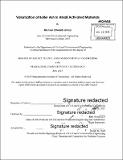| dc.contributor.advisor | John Ochsendorf. | en_US |
| dc.contributor.author | Laracy, Michael Edward | en_US |
| dc.contributor.other | Massachusetts Institute of Technology. Department of Civil and Environmental Engineering. | en_US |
| dc.coverage.spatial | a-ii--- | en_US |
| dc.date.accessioned | 2015-10-30T18:57:39Z | |
| dc.date.available | 2015-10-30T18:57:39Z | |
| dc.date.copyright | 2015 | en_US |
| dc.date.issued | 2015 | en_US |
| dc.identifier.uri | http://hdl.handle.net/1721.1/99582 | |
| dc.description | Thesis: S.M., Massachusetts Institute of Technology, Department of Civil and Environmental Engineering, 2015. | en_US |
| dc.description | Cataloged from PDF version of thesis. | en_US |
| dc.description | Includes bibliographical references (pages 97-102). | en_US |
| dc.description.abstract | For centuries the clay fired brick has been the most popular building material in India due to its local availability and low cost. Despite the growing demand for bricks, some negative environmental and social impacts surrounding its production raise concerns about its future use. In parallel, a growth in industry is generating a number of industrial wastes, such as boiler ash, which are often disposed of in ways that are harmful to the population and the environment. Due to its highly variable physical and chemical properties, boiler ash currently has no viable applications, providing an opportunity to identify a solution. This research seeks to partially solve both the brick and the waste problem by recycling boiler ash into masonry construction materials. This is accomplished using alkali activation, a low energy approach which relies on a chemical reaction to give the product its strength. The aim is to create a mix design which is robust enough to account for the variability in the ash and which produces a high performing masonry unit that is both economically and environmentally sustainable. This work presents two key contributions in service of this goal. Firstly, the physical, chemical, and mineralogical properties of three different boiler ashes are characterized to assess their suitability for alkali activation. Second, a robust mix is developed and the mechanical properties of the resulting products are studied. The boiler ash has many undesirable characteristics for alkali activation, including varying shape, large particle sizes ranging from 5-600 micron, loss on ignition between 8-35%, and less than 4% alumina. However, when combined with supplementary materials in the form of clay and lime, high compressive strengths are observed in the bricks made with all three ashes, demonstrating the robustness of the mix design. The final brick formulation with a solids phase of ash/clay/lime = 70/20/10, liquid to solid ratio = 0.45, and NaOH concentration = 2M produced bricks with compressive strengths between 11-15 MPa after 28 days curing at 30°C. Furthermore, early strength development is observed as more than 55% of the 28 day strength is achieved after one day curing. | en_US |
| dc.description.statementofresponsibility | by Michael Edward Laracy. | en_US |
| dc.format.extent | 102 pages | en_US |
| dc.language.iso | eng | en_US |
| dc.publisher | Massachusetts Institute of Technology | en_US |
| dc.rights | M.I.T. theses are protected by copyright. They may be viewed from this source for any purpose, but reproduction or distribution in any format is prohibited without written permission. See provided URL for inquiries about permission. | en_US |
| dc.rights.uri | http://dspace.mit.edu/handle/1721.1/7582 | en_US |
| dc.subject | Civil and Environmental Engineering. | en_US |
| dc.title | Valorization of boiler ash in alkali activated material | en_US |
| dc.type | Thesis | en_US |
| dc.description.degree | S.M. | en_US |
| dc.contributor.department | Massachusetts Institute of Technology. Department of Civil and Environmental Engineering | |
| dc.identifier.oclc | 925473647 | en_US |
